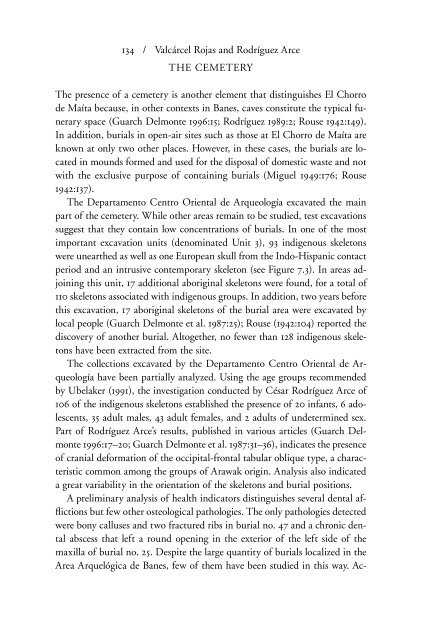Dialogues in Cuban Archaeology
by L. Antonio Curet, Shannon Lee Dawdy, and Gabino La Rosa Corzo
by L. Antonio Curet, Shannon Lee Dawdy, and Gabino La Rosa Corzo
You also want an ePaper? Increase the reach of your titles
YUMPU automatically turns print PDFs into web optimized ePapers that Google loves.
134 / Valcárcel Rojas and Rodríguez Arce<br />
THE CEMETERY<br />
The presence of a cemetery is another element that dist<strong>in</strong>guishes El Chorro<br />
de Maíta because, <strong>in</strong> other contexts <strong>in</strong> Banes, caves constitute the typical funerary<br />
space (Guarch Delmonte 1996:15; Rodríguez 1989:2; Rouse 1942:149).<br />
In addition, burials <strong>in</strong> open-air sites such as those at El Chorro de Maíta are<br />
known at only two other places. However, <strong>in</strong> these cases, the burials are located<br />
<strong>in</strong> mounds formed and used for the disposal of domestic waste and not<br />
with the exclusive purpose of conta<strong>in</strong><strong>in</strong>g burials (Miguel 1949:176; Rouse<br />
1942:137).<br />
The Departamento Centro Oriental de Arqueología excavated the ma<strong>in</strong><br />
part of the cemetery. While other areas rema<strong>in</strong> to be studied, test excavations<br />
suggest that they conta<strong>in</strong> low concentrations of burials. In one of the most<br />
important excavation units (denom<strong>in</strong>ated Unit 3), 93 <strong>in</strong>digenous skeletons<br />
were unearthed as well as one European skull from the Indo-Hispanic contact<br />
period and an <strong>in</strong>trusive contemporary skeleton (see Figure 7.3). In areas adjo<strong>in</strong><strong>in</strong>g<br />
this unit, 17 additional aborig<strong>in</strong>al skeletons were found, for a total of<br />
110 skeletons associated with <strong>in</strong>digenous groups. In addition, two years before<br />
this excavation, 17 aborig<strong>in</strong>al skeletons of the burial area were excavated by<br />
local people (Guarch Delmonte et al. 1987:25); Rouse (1942:104) reported the<br />
discovery of another burial. Altogether, no fewer than 128 <strong>in</strong>digenous skeletons<br />
have been extracted from the site.<br />
The collections excavated by the Departamento Centro Oriental de Arqueología<br />
have been partially analyzed. Us<strong>in</strong>g the age groups recommended<br />
by Ubelaker (1991), the <strong>in</strong>vestigation conducted by César Rodríguez Arce of<br />
106 of the <strong>in</strong>digenous skeletons established the presence of 20 <strong>in</strong>fants, 6 adolescents,<br />
35 adult males, 43 adult females, and 2 adults of undeterm<strong>in</strong>ed sex.<br />
Part of Rodríguez Arce’s results, published <strong>in</strong> various articles (Guarch Delmonte<br />
1996:17–20; Guarch Delmonte et al. 1987:31–36), <strong>in</strong>dicates the presence<br />
of cranial deformation of the occipital-frontal tabular oblique type, a characteristic<br />
common among the groups of Arawak orig<strong>in</strong>. Analysis also <strong>in</strong>dicated<br />
a great variability <strong>in</strong> the orientation of the skeletons and burial positions.<br />
A prelim<strong>in</strong>ary analysis of health <strong>in</strong>dicators dist<strong>in</strong>guishes several dental af-<br />
®ictions but few other osteological pathologies. The only pathologies detected<br />
were bony calluses and two fractured ribs <strong>in</strong> burial no. 47 and a chronic dental<br />
abscess that left a round open<strong>in</strong>g <strong>in</strong> the exterior of the left side of the<br />
maxilla of burial no. 25. Despite the large quantity of burials localized <strong>in</strong> the<br />
Area Arquelógica de Banes, few of them have been studied <strong>in</strong> this way. Ac-


















